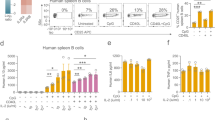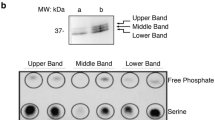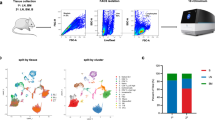Abstract
Interleukin-2 (IL-2) is a T-cell-derived polypeptide hormone of 133 amino acids which exerts its growth-promoting activity via a surface receptor1. Originally, IL-2 was believed to be a unique growth factor for activated T cells2; more recent studies, however, have demonstrated that certain B-cell tumours3 as well as normal activated B lymphocytes4–6 express a surface molecule which is recognized by monoclonal antibodies directed against the IL-2 receptor. Furthermore, we7 and others6 have shown recently that activated B cells proliferate in response to either immunoaffinity-purified8 or recombinant9 IL-2. These controversial findings prompted us to undertake a detailed quantitative comparison of IL-2 receptor expression on activated B and T cells. We show here, using biosynthetically labelled IL-2 (3H-IL-2) and anti-IL-2 receptor antibody (3H-PC61) that activated B and T cells express both high-affinity (apparent dissociation constant, Kd ∼ 20 pM) and low-affinity (Kd ∼1,000 pM) IL-2 receptors. Binding of IL-2 to both classes of receptor is inhibited by the monoclonal anti-IL-2 receptor antibody PC61. B blasts express half as many total IL-2 binding sites or PC61 binding sites as T blasts, and the ratio of the number of low- to high-affinity receptors for each cell type is ∼10:1. Immunoprecipitation analysis of surface-labelled blasts indicates that B and T cells have IL-2 receptors of similar relative molecular mass. Taken together, these data suggest strongly that IL-2 can act as a growth hormone for both B and T lymphocytes.
This is a preview of subscription content, access via your institution
Access options
Subscribe to this journal
Receive 51 print issues and online access
$199.00 per year
only $3.90 per issue
Buy this article
- Purchase on Springer Link
- Instant access to full article PDF
Prices may be subject to local taxes which are calculated during checkout
Similar content being viewed by others
References
Smith, K. A. A. Rev. Immun. 2, 319–333 (1984).
Robb, R. J., Munck, A. & Smith, K. A. J. exp. Med. 154, 1455–1464 (1981).
Korsmeyer, S. J. et al. Proc. natn. Acad. Sci. U.S.A. 80, 4522–4526 (1983).
Malek, T. R., Robb, R. J. & Shevach, E. M. Proc. natn. Acad. Sci. U.S.A. 80, 5694–5698 (1983).
Osawa, H. & Diamantstein, T. J. Immun. 132, 2445–2450 (1984).
Tsudo, M. et al. J. exp. Med. 160, 612–617 (1984).
Zubler, R. H. et al. J. exp. Med. 160, 1170–1183 (1984).
Smith, K. A., Favata, M. F. & Oroszlan, S. J. Immun. 131, 1808–1815 (1983).
Devos, R. et al. Nucleic Acids Res. 11, 4307–4323 (1983).
Ceredig, R. et al. Nature 314, 98–100 (1985).
Robb, R. J., Greene, W. C. & Rusk, C. M. J. exp. Med. 160, 1126–1146 (1984).
King, A. C. & Cuatrecasas, P. J. biol. Chem. 257, 3053–3060 (1982).
Rees, A. R. et al. EMBO J. 3, 1843–1847 (1984).
Knutson, V. P. et al. Proc. natn. Acad. Sci. U.S.A. 79, 2822–2826 (1982).
Raizada, M. K. & Perdue, J. F. J. biol. Chem. 251, 6445–6455 (1976).
Ortega, G. R. et al. J. Immun. 133, 1970–1975 (1984).
Osawa, H. & Diamantstein, T. J. Immun. 130, 51–55 (1983).
Leonard, W. J. et al. Nature 300, 267–269 (1982).
Depper, J. M. et al. J. Immun. 133, 1691–1695 (1984).
Lowenthal, J. W. et al. J. Immun. 134, 931–939 (1985).
Nabholz, M. et al. Immun. Rev. 51, 125–156 (1980).
Munson, P. J. & Rodbard, D. Analyt. Biochem. 107, 220–239 (1980).
MacDonald, H. R. & Zaech, P. Cytometry 3, 55–58 (1982).
Hubbard, A. L. & Cohn, Z. A. J. Cell Biol. 64, 438–460 (1975).
Luescher, B. et al. Molec. Immun. 21, 329–336 (1984).
Bordier, C. J. biol. Chem. 256, 1604–1607 (1981).
Laemmli, U. K. Nature 221, 680–685 (1970).
Gillis, S. et al. J. Immun. 120, 2027–2032 (1978).
Author information
Authors and Affiliations
Rights and permissions
About this article
Cite this article
Lowenthal, J., Zubler, R., Nabholz, M. et al. Similarities between interleukin-2 receptor number and affinity on activated B and T lymphocytes. Nature 315, 669–672 (1985). https://doi.org/10.1038/315669a0
Received:
Accepted:
Issue Date:
DOI: https://doi.org/10.1038/315669a0
This article is cited by
-
The gene expression profile and cell of origin of canine peripheral T-cell lymphoma
BMC Cancer (2024)
-
Insights into non-autoimmune type 1 diabetes with 13 novel loci in low polygenic risk score patients
Scientific Reports (2021)
-
CD122-targetted IL-2 signals cause acute and selective apoptosis of B cells in Peyer’s Patches
Scientific Reports (2020)
-
Qualitative differences in brain-infiltrating T cells are associated with a fatal outcome in mice infected with Japanese encephalitis virus
Archives of Virology (2015)
-
Cellular and cytokine-dependent immunosuppressive mechanisms of grm1-transgenic murine melanoma
Cancer Immunology, Immunotherapy (2012)
Comments
By submitting a comment you agree to abide by our Terms and Community Guidelines. If you find something abusive or that does not comply with our terms or guidelines please flag it as inappropriate.



